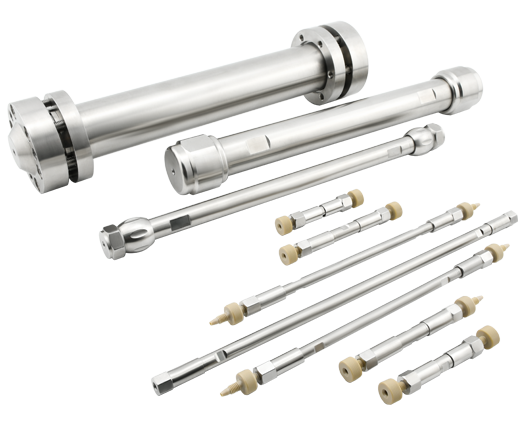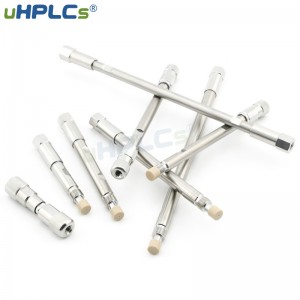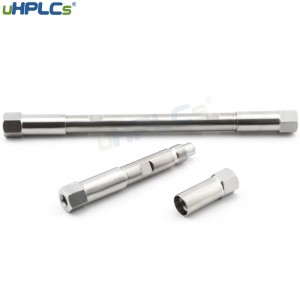
A complete chromatographic column, i.e., a high performance liquid chromatography column system, should have a Column Head and a matching Connection Tube in addition to the packed column tube. The column head should have a PEEK Cap and an HPLC Frit, which is the Column Frit Cap.
The inner wall of the HPLC column is carefully processed to make the inner surface of the column tube smooth with a 0.1μ finish, thus reducing the groove flow phenomenon of the inner wall attachment and the inhomogeneity of the wall packing layer, and reducing the broadening of the spectrum caused by the column wall. uHPLCs use unique process technology to polish it to mirror surfaces.



The application range of HPLC is very wide. In order to meet the diversified analytical needs, Hundersun Scientific Instruments Limited (uHPLCs) has launched two series of columns, USHA and USHB, based on high purity silica, with 8 types of packing materials and 7 types of C18 (octadecylsilane, ODS) packing materials with different performance. uHPLCs' years of accumulated HPLC development experience and uHPLCs' years of experience in HPLC development and extensive column lineup can favorably support your analytical work.
uHPLCs HPLC Columns - Silica Gel Chromatography Packings - USHA Series and USHB Series
|
HPLC Column Packing |
Physical and Chemical Parameters |
Features and Applications |
Specifications of HPLC Column (mm) |
|||||
|
Particle Size (μm)
|
Pore Size ( A) |
Carbon Content (% ) |
PH Stability |
End-apping |
Separation mode |
|||
|
USHA C18 |
1.8 2 3 5 10 20 30 or even bigger particles |
70 100 120 200 300 etc. |
17 |
2~8 |
Yes |
Reversed-phase |
- High selection and high separation.
- Widely used in in the analysis of polar and hydrophobic substances, the first choice of all kinds of compounds. |
2.1x30 2.1x50 2.1x75 2.1x100 2.1x150 3.0x50 3.0x100 3.0x150 4.6x30 4.6x50 4.6x100 4.6x150 4.6x250 10x50 10x100 10x150 10x250 20x50 20x150 20x200 20x250 20x300 30x150 30x250 50x150 50x250 |
|
USHA C18-G |
18 |
1~12 |
One-End-capping |
Reversed-phase |
- High selection and high separationl High- efficiency column
- A wide range of pH values, the first choice of all insulin substances - Widely used in the analysis of polar and hydrophobic substances |
|||
|
USHA C18-BIO |
17.5 |
2~10 |
Double End-capping |
Reversed-phase |
- Specially designed for the separation of various alkaline compounds.
- The pH tolerance range is 2~9. |
|||
|
USHA C18-T |
19 |
1.5~11 |
Double End-capping |
Reversed-phase |
- Designed for selective separation, aim for high quality separation and purification. | |||
|
USHA C18-N |
16 |
2~8 |
No |
Reversed-phase |
- Unique bonding mode, can achieve 100% water phase condition. | |||
|
USHA C18-AQ |
13 |
2~8 |
Yes |
Reversed-phase |
- C18 and polar group. | |||
|
USHA C18-A |
10 |
2~8 |
Yes |
Reversed-phase |
- Low carbon content, suitable for separation of strongly polar and hydrophilic compounds. | |||
|
USHA C8 |
10 |
2~8 |
Yes |
Reversed-phase |
- C8 has a relatively low hydrophobicity compared with C18 stationary, suitable for the separation of most hydrophobic compounds, more suitable for separating compounds with strong adsorption on C18 column. | |||
|
USHA C4 |
3 |
2~8 |
Yes |
Reversed-phase |
- Suitable for the separation of polar and hydrophobic substances in C18 and C8 separation for too long. | |||
|
USHA Phenyl (USHA phenyl column) |
12 |
2~8 |
Yes |
Reversed-phase |
- π- π interaction shows selectivity difference from that ofC18. | |||
|
USHA NH2 (USHA amino column) |
4 |
2~8 |
Yes |
Normal-phase Reversed-phase |
- Strong polarity can be both positive and negative; The amino functional group provides a retention that allows the analysis of polar compounds under normal phase elution conditions. - Organic compounds in monosaccharides and polyglycans/ olefines/aromatics can be analyzed by acetonitrile and water. - In the buffer of low pH value, there is weak anion exchange which can separate some negatively charged molecules. |
|||
|
USHA CN (USHA cyan column) |
6 |
2~8 |
Yes |
Normal-phase Reversed-phase |
- Medium polarity cyanogroup, can be used in both positive andnegative phases.
- The hydrophobicity is relatively low in the stationary phase of reversed-phase chromatography and shows a different selectivity from that of C18 due to the π-electron interaction of the cyanide group. - Suitable for separation of components that have been separated for too long on C18, and suitable for the occasion where is very difficult to optimize the chromatogram on C18. - When very hydrophobic compounds cannot be eluted using standard C18 and C8 reversed-phase column, the most polarized inverting column can be a cyanide column. |
|||
|
USHA Diol |
5 |
2~7 |
No |
Normal-phase Hilic |
- Separation of polar and basic compounds using silanol residues. | |||
|
USHA SiL |
3 5 7 9 10 20 30 or even bigger particles |
70 120 150 200 300 etc. |
-- |
1~6 |
Yes |
Normal-phase Hilic |
- <10ppm high purity spherical silica gel, very low metal impurities. - Can be used to separate polar and basic organic compounds, such as vitamins, steroids, and many other drug molecules. |
|
|
USHB C18 |
17 |
2~8 |
Yes |
Reversed-phase |
- Exellent stability and repeatability, full cover bonded silica gelwas used as packing.- High selectivity and high separation. | |||
|
USHB C18-BIO |
20 |
1.5~10 |
Double End-capping |
Reversed-phase |
- Specially designed for the separation of all kind of alkali compounds, the pH tolerance range can be 1.5-10. | |||
|
USHB C18-BP |
14 |
2~7.5 |
Yes |
Reversed-phase |
- Low carbon content, suitable for separation of hydrophilic and polar compounds, and 100% pure water mobile phase. | |||
|
USHB C8 |
10 |
2~8 |
Yes |
Reversed-phase |
- Suitable for separating most hydrophobic compounds | |||
|
USHB SiL |
-- |
1~6 |
No |
Normal-phase Hilic |
- High purity spherical silica gel (metal impurities < l0ppm), withhigh column efficiency and good peak shape characteristics.
- Can be used to separate polar and basic organic compounds. |
|||
FAQ
Chromatographic column parameters: stationary phase, column length, inner diameter.
Stationary phase selection: Similarity solubility principle.
Non-/weakly polar columns - most commonly used! Medium polarity columns - for complex/difficult separations, strong polarity columns - are mostly used for special applications.
Column length: 10-15m for rapid analysis of simple samples with typically less than ten components;
25-30m standard column length for most applications;
50m, 60m, and 100m for complex samples;
Internal diameter: 0.53mm large diameter can be used as a replacement for packed columns for larger volumes and trace analysis;
0.32mm wide bore, split/unsplit injection, can handle large volumes;
0.25mm narrow diameter split injection, GC/MS applications, high column efficiency;
0.18mm micro diameter for fast separation and high column efficiency;
0.10mm fast GC, high instrument requirements for fast separation.
60℃ - the lower temperature limit, below which the column efficiency will be reduced but will not damage the column.
240℃——the upper limit of thermostat temperature, can be used at this temperature for a long time.
260°C - the upper limit of the programmed temperature, which should not be exceeded and should not be used at this temperature for more than 10 minutes.
To rinse a reversed-phase column:
Rinse the column (analytical column) with at least 25 mL of each of the following solvents
- Mobile phase without buffer salts
- 100% methanol
- 100% acetonitrile
- 75% acetonitrile + 25% isopropanol
- 100% isopropanol
- 100% methylene chloride *
- 100% hexane*
*If the column is flushed with hexane or methylene chloride, the column must be flushed with isopropanol before reusing the reversed-phase.
If the column is flushed with hexane or methylene chloride, the column must be flushed with isopropanol before reusing the reversed-phase mobile phase !!!
Normal phase chromatography column flushing:
Rinse the column (analytical column) with at least 50 mL of each of the following solvents
50% methanol + 50% trichloromethane
100% ethyl acetate
When using HPLC, special attention should be paid to the effect of the "off-column effect" on the analytical results. The diffusion coefficient of sample molecules in the liquid mobile phase is 4-5 orders of magnitude smaller than in the gas, and the flow rate of the liquid mobile phase is 1-2 orders of magnitude slower than that of the gas phase. Therefore, after the sample enters the column, the diffusion and retention of sample molecules in any dead volume outside the column (injector, column junction, connecting tube, detector) will cause the spreading of the chromatographic peak, and the column efficiency will be reduced. To minimize the out-of-column effect and obtain ideal analytical results, the mobile phase tubing connection of the instrument is very important. The customer only needs to pay attention to the joint processing when replacing the column. Generally, the column inlet joint is stainless steel, and the column outlet is stainless steel or PEEK line hand screw street. When the first installation is completed, the stainless steel ferrule has been fixed dead. When connecting different columns, pay attention to the shape and length of the column joint. Otherwise, it will produce a very large dead volume.
HPLC has the following features:
High pressure-Pressure up to 150~300 Kg/cm2. Column pressure drop per meter is 75 Kg/cm2 or more.
High speed: Flow rate is 0.1~10.0 ml/min.
High efficiency - up to 5000 plates per meter. Simultaneous separation of up to 100 components in one column.
High sensitivity - UV detector sensitivity up to 0.01 ng and low sample consumption.
Fast speed - usually analyze a sample in 15-30 min. Some samples can be finished in 5 min.
High-resolution - stationary and mobile phases can be selected to achieve optimal separation.
High sensitivity - UV detector up to 0.01ng, fluorescence and electrochemical detectors up to 0.1pg.
Columns can be used repeatedly - different compounds can be separated with one column.
Low sample volume and easy recovery: The sample is not destroyed after passing through the column and can be collected as a single component or made preparative.





